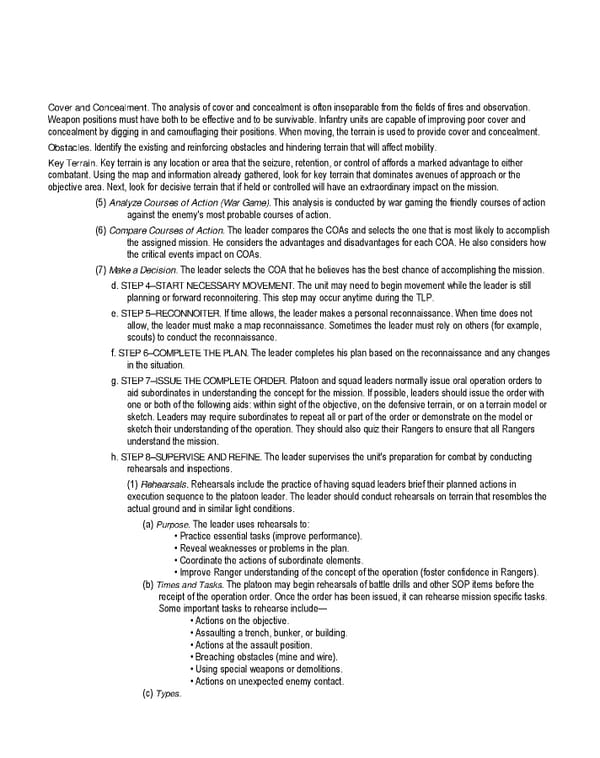Cover and Concealment. The analysis of cover and concealment is often inseparable from the fields of fires and observation. Weapon positions must have both to be effective and to be survivable. Infantry units are capable of improving poor cover and concealment by digging in and camouflaging their positions. When moving, the terrain is used to provide cover and concealment. Obstacles. Identify the existing and reinforcing obstacles and hindering terrain that will affect mobility. Key Terrain. Key terrain is any location or area that the seizure, retention, or control of affords a marked advantage to either combatant. Using the map and information already gathered, look for key terrain that dominates avenues of approach or the objective area. Next, look for decisive terrain that if held or controlled will have an extraordinary impact on the mission. (5) Analyze Courses of Action (War Game). This analysis is conducted by war gaming the friendly courses of action against the enemy's most probable courses of action. (6) Compare Courses of Action. The leader compares the COAs and selects the one that is most likely to accomplish the assigned mission. He considers the advantages and disadvantages for each COA. He also considers how the critical events impact on COAs. (7) Make a Decision. The leader selects the COA that he believes has the best chance of accomplishing the mission. d. STEP 4–START NECESSARY MOVEMENT. The unit may need to begin movement while the leader is still planning or forward reconnoitering. This step may occur anytime during the TLP. e. STEP 5–RECONNOITER. If time allows, the leader makes a personal reconnaissance. When time does not allow, the leader must make a map reconnaissance. Sometimes the leader must rely on others (for example, scouts) to conduct the reconnaissance. f. STEP 6–COMPLETE THE PLAN. The leader completes his plan based on the reconnaissance and any changes in the situation. g. STEP 7–ISSUE THE COMPLETE ORDER. Platoon and squad leaders normally issue oral operation orders to aid subordinates in understanding the concept for the mission. If possible, leaders should issue the order with one or both of the following aids: within sight of the objective, on the defensive terrain, or on a terrain model or sketch. Leaders may require subordinates to repeat all or part of the order or demonstrate on the model or sketch their understanding of the operation. They should also quiz their Rangers to ensure that all Rangers understand the mission. h. STEP 8–SUPERVISE AND REFINE. The leader supervises the unit's preparation for combat by conducting rehearsals and inspections. (1) Rehearsals. Rehearsals include the practice of having squad leaders brief their planned actions in execution sequence to the platoon leader. The leader should conduct rehearsals on terrain that resembles the actual ground and in similar light conditions. (a) Purpose. The leader uses rehearsals to: • Practice essential tasks (improve performance). • Reveal weaknesses or problems in the plan. • Coordinate the actions of subordinate elements. • Improve Ranger understanding of the concept of the operation (foster confidence in Rangers). (b) Times and Tasks. The platoon may begin rehearsals of battle drills and other SOP items before the receipt of the operation order. Once the order has been issued, it can rehearse mission specific tasks. Some important tasks to rehearse include— • Actions on the objective. • Assaulting a trench, bunker, or building. • Actions at the assault position. • Breaching obstacles (mine and wire). • Using special weapons or demolitions. • Actions on unexpected enemy contact. (c) Types.
 Ranger Handbook Page 25 Page 27
Ranger Handbook Page 25 Page 27